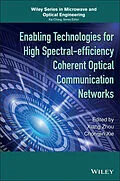Enabling Technologies for High Spectral-efficiency Coherent Optical Communication Networks
Presents the technological advancements that enable high spectral-efficiency and high-capacity fiber-optic communication systems and networks
This book examines key technology advances in high spectral-efficiency fiber-optic communication systems and networks, enabled by the use of coherent detection and digital signal processing (DSP). The first of this book's 16 chapters is a detailed introduction. Chapter 2 reviews the modulation formats, while Chapter 3 focuses on detection and error correction technologies for coherent optical communication systems. Chapters 4 and 5 are devoted to Nyquist-WDM and orthogonal frequency-division multiplexing (OFDM). In chapter 6, polarization and nonlinear impairments in coherent optical communication systems are discussed. The fiber nonlinear effects in a non-dispersion-managed system are covered in chapter 7. Chapter 8 describes linear impairment equalization and Chapter 9 discusses various nonlinear mitigation techniques. Signal synchronization is covered in Chapters 10 and 11. Chapter 12 describes the main constraints put on the DSP algorithms by the hardware structure. Chapter 13 addresses the fundamental concepts and recent progress of photonic integration. Optical performance monitoring and elastic optical network technology are the subjects of Chapters 14 and 15. Finally, Chapter 16 discusses spatial-division multiplexing and MIMO processing technology, a potential solution to solve the capacity limit of single-mode fibers.
- Contains basic theories and up-to-date technology advancements in each chapter
- Describes how capacity-approaching coding schemes based on low-density parity check (LDPC) and spatially coupled LDPC codes can be constructed by combining iterative demodulation and decoding
- Demonstrates that fiber nonlinearities can be accurately described by some analytical models, such as GN-EGN model
- Presents impairment equalization and mitigation techniques
Enabling Technologies for High Spectral-efficiency Coherent Optical Communication Networks is a reference for researchers, engineers, and graduate students.
Autorentext
Xiang Zhou is a Tech Lead within Google Platform Advanced Technology. Before joining Google, he was with AT&T Labs, conducting research on various aspects of optical transmission and photonics networking technologies. Dr. Zhou is an OSA fellow and an associate editor for Optics Express. He has extensive publications in the field of optical communications.
Chongjin Xie is a Senior Director at Ali Infrastructure Service, Alibaba Group. Before joining Alibaba Group, he was a Distinguished Member of Technical Staff at Bell Labs, Alcatel-Lucent. Dr. Xie is a fellow of OSA and senior member of IEEE. He is an associate editor of the Journal of Lightwave Technology and has served in various conference committees.
Inhalt
List of Contributors xv
Preface xvii
1 Introduction 1 Xiang Zhou and Chongjin Xie
1.1 High-Capacity Fiber Transmission Technology Evolution, 1
1.2 Fundamentals of Coherent Transmission Technology, 4
1.2.1 Concept of Coherent Detection, 4
1.2.2 Digital Signal Processing, 5
1.2.3 Key Devices, 7
1.3 Outline of this Book, 8
References, 9
2 Multidimensional Optimized Optical Modulation Formats 13 Magnus Karlsson and Erik Agrell
2.1 Introduction, 13
2.2 Fundamentals of Digital Modulation, 15
2.2.1 System Models, 15
2.2.2 Channel Models, 17
2.2.3 Constellations and Their Performance Metrics, 18
2.3 Modulation Formats and Their Ideal Performance, 20
2.3.1 Format Optimizations and Comparisons, 21
2.3.2 Optimized Formats in Nonlinear Channels, 30
2.4 Combinations of Coding and Modulation, 31
2.4.1 Soft-Decision Decoding, 31
2.4.2 Hard-Decision Decoding, 37
2.4.3 Iterative Decoding, 39
2.5 Experimental Work, 40
2.5.1 Transmitter Realizations and Transmission Experiments, 40
2.5.2 Receiver Realizations and Digital Signal Processing, 45
2.5.3 Formats Overview, 49
2.5.4 Symbol Detection, 50
2.5.5 Realizing Dimensions, 51
2.6 Summary and Conclusions, 54
References, 56
3 Advances in Detection and Error Correction for Coherent Optical Communications: Regular, Irregular, and Spatially Coupled LDPC Code Designs 65 Laurent Schmalen, Stephan ten Brink, and Andreas Leven
3.1 Introduction, 65
3.2 Differential Coding for Optical Communications, 67
3.2.1 Higher-Order Modulation Formats, 67
3.2.2 The Phase-Slip Channel Model, 69
3.2.3 Differential Coding and Decoding, 71
3.2.4 Maximum a Posteriori Differential Decoding, 78
3.2.5 Achievable Rates of the Differentially Coded Phase-Slip
Channel, 81
3.3 LDPC-Coded Differential Modulation, 83
3.3.1 Low-Density Parity-Check (LDPC) Codes, 85
3.3.2 Code Design for Iterative Differential Decoding, 91
3.3.3 Higher-Order Modulation Formats with V < Q, 100
3.4 Coded Differential Modulation with Spatially Coupled LDPC Codes, 101
3.4.1 Protograph-Based Spatially Coupled LDPC Codes, 102
3.4.2 Spatially Coupled LDPC Codes with Iterative Demodulation, 105
3.4.3 Windowed Differential Decoding of SC-LDPC Codes, 108
3.4.4 Design of Protograph-Based SC-LDPC Codes for
Differential-Coded Modulation, 108
3.5 Conclusions, 112
Appendix: LDPC-Coded Differential Modulation-Decoding Algorithms, 112
Differential Decoding, 114
LDPC Decoding, 115
References, 117
4 Spectrally Efficient Multiplexing: Nyquist-WDM 123 Gabriella Bosco
4.1 Introduction, 123
4.2 Nyquist Signaling Schemes, 125
4.2.1 Ideal Nyquist-WDM ( f = Rs), 126
> Rs), 128
4.2.3 Super-Nyquist-WDM ( f < Rs), 130
4.3 Detection of a Nyquist-WDM Signal, 134
4.4 Practical Nyquist-WDM Transmitter Implementations, 137
4.4.1 Optical Nyquist-WDM, 139
4.4.2 Digital Nyquist-WDM, 141
4.5 Nyquist-WDM Transmission, 146
4.5.1 Optical Nyquist-WDM Transmission Experiments, 148
4.5.2 Digital Nyquist-WDM Transmission Experiments, 148
4.6 Conclusions, 149
References, 150
5 Spectrally Efficient Multiplexing - OFDM 157 An Li, Di Che, Qian Hu, Xi Chen, and William Shieh 5.1 OFDM Basics, 158
5.2 Coherent Optical OFDM (CO-OFDM), 161
5.2.1 Principle of CO-OFDM, 161
5.3 Direct-Detection Optical OFDM (DDO-OFDM), 169
5.3.1 Linearly Mapped DDO-OFDM, 169
5.3.2 Nonlinearly Mapped DDO-OFDM (NLM-DDO-OFDM), 173
5.4 Self-Coherent Optical OFDM, 174
5.4.1 Single-Ended Photodetector-Based SCOH, 175
5.4.2 Balanced Receiver-Based SCOH, 177
5.4.3 Stokes Vector Direct Detection, 177
5.5 Discrete Fourier Transform Spread OFDM System (DFT-S OFDM), 180
5.5.1 Principle of DFT-S OFDM, 180
5.5.2 Unique-Word-Assisted DFT-S OFDM (UW-DFT-S OFDM), 182
5.6 OFDM-Based Superchannel Transmissions, 183
5.6.1 No-Guard-Interval CO-OFDM (NGI-CO-OFDM) Superchannel, 184
5.6.2 Reduced-Guard-Interval CO-OFDM (RGI-CO-OFDM) Superchannel, 186
5.6.3 DFT-S OFDM Superchannel, 188
5.7 Summary, 193
References, 194
6 Polarization and Nonlinear Impairments in Fiber Communication Systems 201 Chongjin Xie
6.1 Introduction, 201
6.2 Polarization of Light, 202
6.3 PMD and PDL in Optical Communication Systems, 206
6.3.1 PMD, 206
6.3.2 PDL, 208
6.4 Modeling of Nonlinear Effects in Optical Fibers, 209
6.5 Coherent Optical Communication Systems and Signal Equaliz…
